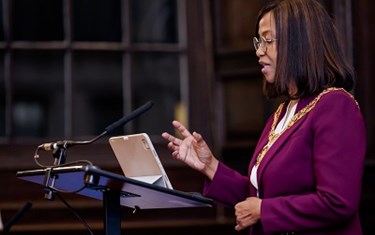
Despite the differences in our systems, planners in the United Kingdom and the United States are facing the same challenges. Planners across both sides of the pond find themselves on the front line against climate resilience, adaptation and mitigation, as well as both a shortage of houses and the qualified planners needed to deliver them.
My recent trip to the American Planning Association (APA) conference was a stark reminder of these similarities. While as big and bold as you would expect from a US-based conference, the razzle-dazzle did not overshadow the importance of the event, nor did it dim its significance.
Attending as President of the Royal Town Planning Institute, my goal was to inform myself of international best practices to ensure the UK planning systems are set up to tackle the problems of today.
I attended several roundtable sessions on topics as varied as scenario planning for climate adaptation and resilience, to presentations on planning for ‘Zoom’ towns and the future of planning for cooler streetscapes. My own session on planning for better access to healthy food proved to be a popular and well-attended talk at the conference. This is a big topic in America, particularly in lower-income areas of large cities.
The conference was almost bursting at the seams with delegates, offering a rare opportunity to connect with other planning leaders from around the world. Speaking with the Presidents of the APA and the Canadian Planning Association provided insight into the challenges and opportunities faced by planners within North America, while speaking with the CEOs in New Zealand and Australia, a member from Hong Kong, and rare, in-person conversations with the Global Planners Network, provided a truly global perspective.
Attendees came from the public sector, government departments, state governments, cities and municipalities, all paid for by employers who recognise the benefits of the conference and the learning opportunities for their staff. However, the true highlight was RTPI’s Young Planner of the Year Simeon Shtebunaev’s infectious enthusiasm. Thank you, Simeon, for being such good company.
The biggest takeaway
For anyone thinking that we should move to a zoning system in an attempt to simplify our planning system – stop it now. Zoning and coding lead to re-zoning and re-coding which is intricate and time consuming. It is inflexible and introducing change is difficult once the zoning is in place. Local zoning plans also lie under comprehensive and strategic spatial plans. It is not as simple as some may think.
On Philadelphia
With our time at APA winding to a close, I was able to spend a happy couple of hours exploring the street and public art in central Philadelphia. 1% of the budget of any project in the city goes toward public art, turning the central area is a living art gallery. Within 100m there is a Barbara Hepworth and a Henry Moore sculptures on the Benjamin Franklin Boulevard, with gable wall murals brightening up the darkest corner.
A friendly, walkable and historic city, of which the residents are very proud. It is no surprise why, when looking at the arboriculture in the city’s tree-lined streets. The blossom came out as we toured the city. Pretty and, I imagine, providing necessary share and cooling for pedestrians in the summer months. A lesson there for us all.


